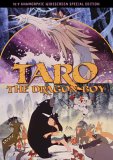| Reviews & Columns |
|
Reviews DVD TV on DVD Blu-ray 4K UHD International DVDs In Theaters Reviews by Studio Video Games Features Collector Series DVDs Easter Egg Database Interviews DVD Talk Radio Feature Articles Columns Anime Talk DVD Savant Horror DVDs The M.O.D. Squad Art House HD Talk Silent DVD
|
DVD Talk Forum |
|
|
| Resources |
|
DVD Price Search Customer Service #'s RCE Info Links |
|
Columns
|
|
|
Taro, the Dragon Boy
In feudal Japan young Taro, a stocky little boy living with his grandmother in a remote, mountainous village, is regarded by his neighbors as "a glutton and a sloth." He does indeed appear lazy, whiling away the day snoozing on his tatami while his poor grandmother slaves away farming millet, as the land there is too rocky and mountainous to grow rice or anything else. But Taro is merely immature; he has a kind heart, sharing his food with his animal friends.
Taro eventually learns from his grandmother that his long-lost mother years ago was transformed into a dragon and still lives, albeit at the bottom of a lake many mountains north of their village. Instantly Taro begins a long odyssey to find her, encountering various demons, witches, snow women, and other fantastic creatures along the way. (The mother/dragon's voice is provided by actress Sayuri Yoshinaga, who starred in a number of live-action films also helmed by Taro, the Dragon Boy's supervising director, Kiriro Urayama.)
Taro, the Dragon Boy is for the most part exquisitely made, with beautifully designed backgrounds, expressive characters, and thoughtful mise-en-scene, all of which compensate for the limited (budget-driven) animation, which lacks the relative fluidity of Hollywood-produced feature film animation. Admirably though, the film looks nothing like Disney or anything else being made by American animators; it looks less like, say, Mulan than the work of animators from Eastern European or the former Soviet Union (especially in the design of some of the animals).
The lovely abstract backgrounds are rendered in the style of sumie, Chinese ink painting, and do an exceptionally fine job evoking the oppressive, mountainous landscapes required by the story. As is par for the course with Japanese anime, mood is expressed with a minimum of motion, with relatively simple shots going a long way to establish the atmosphere of a particular scene, from the dragonflies delicately swarming above the rice crop ready to be harvested, to the chilliness of winter in the lap dissolves of snow falling on Taro's frozen body, and the yukionna ("Snow Women") that threaten him.
The film makes superb use of the CinemaScope-shaped frame, with striking compositions throughout. Disney and other American cartoon factories tended to avoid 'scope like the plague but, during the 1960s and '70s anyway, Japanese animators often filmed their animated features in 'scope, and visually the results were often quite spectacular, as is the case here.
Also worth noting is the memorable and imaginative score by Riichiro Manabe, a wildly inconsistent composer who worked on a wide range of films, from Oshima's Cruel Story of Youth to Godzilla vs. the Smog Monster. Many of the scores from the 1970s are jaw-droppingly bad, but Taro, the Dragon Boy apparently inspired him.
The film's singular "Japaneseness" undoubtedly discouraged potential American distribution when it was new but provides endless fascination now. There are, for instance, ideas that would be considered too gruesome for American animation even today, such as flashback scenes of Taro suckling on his mother's eyeballs for nourishment. (As a dragon, Taro's mother sacrifices her sight to feed her infant son.) Other references would be instantly recognizable to Japanese children but lost on most American audiences, such as the appearance of the Akaoni, the Red Demon of Thunder and Lightning that, among other things, is a fixture on TV weather reports.
More perplexing and probably shocking to prudish Americans is the film's casual and unashamed nudity, from Taro's genitals, which are inadvertently flashed when he stands on his head, to the surprising but completely logical appearance of semi-naked women several times during the story. The film is suitable for all ages, however, and such scenes will probably bother parents much more than their kids. (It is amusing to imagine Toei's international sales department scratching their heads back in 1979, wondering why American distributors kept passing on such a fine film, unaware that the film's nudity instantly killed any deals that might have been in the offing.)
Video & Audio
Taro, the Dragon Boy is presented in a handsome 16:9 enhanced transfer that retains the crucial original framing, is bright and sharp and outside of a few age-related flaws near-perfect. The subtitles are especially good and done with obvious care. The film is offered in both its original Japanese mono (with optional English subtitles) and in a mono, English-dubbed version supervised by Peter Fernandez. Though the English version isn't awful, the Japanese performances are superior and better-conform to the material. The English audio includes optional "limited subtitles" for Japanese signage and whatnot.
Extra Features
Extras are limited to a Trailer, which offers some behind-the-scenes footage with key creative personnel.
Parting Thoughts
Though pretty much unknown outside of Asia, Taro, the Dragon Boy is an excellent film, one sure to enchant both adults and children alike.
Stuart Galbraith IV is a Kyoto-based film historian whose work includes The Emperor and the Wolf - The Lives and Films of Akira Kurosawa and Toshiro Mifune and Taschen's forthcoming Cinema Nippon. Visit Stuart's Cine Blogarama here.
|
| Popular Reviews |
| Sponsored Links |
|
|
| Sponsored Links |
|
|
| Release List | Reviews | Shop | Newsletter | Forum | DVD Giveaways | Blu-Ray | Advertise |
|
Copyright 2024 DVDTalk.com All Rights Reserved. Legal Info, Privacy Policy, Terms of Use,
Manage Preferences,
Your Privacy Choices | |||||||













